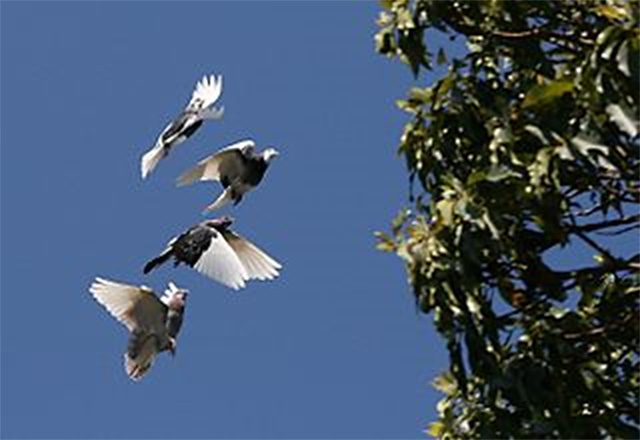
Credit: Toby Hudson (own work; CC BY-SA 3.0 [http://creativecommons.org/licenses/by-sa/3.0] or GFDL [http://www.gnu.org/copyleft/fdl.html]), via Wikimedia Commons
There’s a good chance that a dinosaur once stomped through your backyard. It’s more likely, though, that there’s one there today. I’m talking, of course, about birds.
How exactly is T. rex related to the common house sparrow?
Around 230 million years ago, there was a group of dinosaurs called the theropods, which included the bipedal carnivores.
With their back legs used for movement, their front legs were free to specialize. In T. rex, they became, well, not much. But in other species they became grasping claws.
While T-rex and his cousins were getting bigger, the grasping-claw dinosaurs got smaller. One of these subgroups, the coelurosaurs, evolved two important things:
They became omnivores, so they could survive on a broader diet.
And they grew early feathers, perhaps to keep warm. Suggesting they may have also become warm-blooded, like birds.
With these traits in place, this group evolved rapidly. They got smaller still and developed early wings, for hopping and then gliding.
This was a huge advantage, which encouraged ever-more-capable flight. Over millions more years, they evolved sophisticated feathers and hollow bones.
Finally, to navigate in three dimensions and across huge areas, they developed greater brainpower and better communication systems.
When that asteroid hit Earth 66 millions years ago, it ended the reign of T. rex. But birds, with their new capabilities, flew on. So look for a little dinosaur on your windowsill.
Background

Credit: benjamint444 (own work; GFDL [http://www.gnu.org/copyleft/fdl.html] or CC-BY-SA-3.0 [http://creativecommons.org/licenses/by-sa/3.0/]), via Wikimedia Commons
Synopsis: Not all dinosaurs became extinct after the asteroid impact 66 million years ago…they live with us in great abundance and variety all over the world!
- Birds, from tiny hummingbirds to stately eagles to waddling ducks and penguins, all descended from the same branch of the dinosaur family tree as Tyrannosaurus rex—theropods. Two other related branches are saurischians, like Titanosaurus, and ornithischians, like Stegosaurus.
- The first dinosaurs appeared in the Middle Triassic nearly 250 million years ago; about 20 million years later, the three branches were evolving separately.
- Most dinosaurs grew larger and larger. Saurischians grew to amazing sizes; by 100 million years ago (Cretaceous), some grew to 130 ft long, 50 ft tall, and nearly 100 tons.
- But starting about 200 million years ago, one type of Late Triassic theropod, coelurosaurs, started getting progressively smaller, which proved to be a perpetual evolutionary advantage for them to this day!
- In the Late Jurassic, 165–150 million years ago, members of the Aves group became distinctly birdlike, giving them nearly 100 million more years to perfect their avian qualities before the extreme environmental stresses of the Late Cretaceous.
- Birds have specific characteristics, many inherited from theropod ancestors who deliberately evolved avian features.
- First, they developed the ability to balance and walk on two legs.
- Then came simple feathers for insulation, followed by wishbones.
- They developed beaks from toothy jaws 85 million years ago. At the same time, descendants kept growing smaller and lighter, eventually developing hollow bones.
- Complex feathers then evolved for camouflage and mating, as well as for gliding and powered flight.
- They then developed wings, first to help them hop, then for gliding, and finally for powered flight as joints adapted and wing-to-weight ratio increased.
- Therapods smartened up when larger brains evolved, enabling them to manage the complex actions of flight.
- Syrinxes evolved, enabling more-complex communication like honking and, eventually, singing.
- Once theropods had developed their new capabilities, they began evolving faster than other dinosaurs as they successfully occupied many new habitats and niches that larger animals could not access.
- A 66–68 million year old fossil from Antarctica was capable of honking and appears to have been an early member of today’s waterfowl group—this means birds had already been branching out into ducks, chickens, and the ostrich group while T. Rex dominated Earth!
- After the mass extinction 66 million years ago, a few bird lineages survived—smaller size, larger brains, and the ability to fly might have made it possible for them to find livable niches.
- Just 16 million years later (50 million years ago), surviving therapod lineages produced an amazing diversity of birds that flourished in the Cenozoic Era.
- Today, there are as many as 18,000 species of birds!

